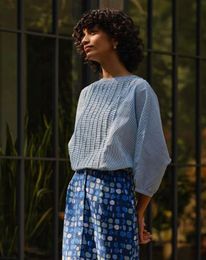In Mumbai, where I live and work, there is a severe heatwave going on. The highest temperature this month has been 40 degrees, sweltering and humid for the coastal city. Of course this is a savage reminder of climate change, and how brutal even its early effects are. Even as some of us may be privileged to remain in air-conditioned environs of the home or the office, a majority of people in the city do not have access to climate control. They live in small, poorly ventilated and crowded rooms, and leaving home is usually an escape.
India has always been a hot and humid country. But how wonderful times may have been when we dressed for the summer. Even nobles wore soft, diaphanous muslin, Indian mulmul or its more sophisticated avatar of jamdani. This gossamer-like fabric was the specialty of Bengal and Bangladesh, and remains the finest fabric made by human hands. European colonisers found it shameless because of its transparent nature, and yet it is the only fabric they would wear to face our summers.
Humans have always dressed for the weather. But globalisation and industrialisation have wreaked havoc on our wardrobes. Clothing is expected to be mass produced, factory made and make fat profit by creating cheap, even unhealthy fabrics to dress a vast population. Thus polyester, nylon, and a whole host of flammable, heat-inducing and microplastic-filled fabrics now crowd our wardrobes. Don’t even say fast fashion, Zara and H&M never claimed to give you quality clothing, just trendy stuff.
India has always been an agrarian country. Our villages created ‘slow fashion’ as we understand it today. Everything the villagers wore, and many continue to wear today, pays respect to the environment. They made clothes without electricity; looms still don’t consume it, but work on mechanised levers—like hand pumps or bicycles do. A large frame ‘builds’ the fabric, a long tooth comb separates the threads, and a mousey shuttle creates the warp and weft.
Thread was spun from rain-harvested plant fibre, fabrics were dyed using spices, fruit, vegetables, mud and soot. Clothing was made from nature. It was vibrant, and it was cooling.
Even winter wear came from sheep or animal hide. Nobody went out to kill an animal for its skin, animals were greatly respected for the food and milk they provided. Their carcasses were repurposed into gorgeous, functional and long-lasting leather, giving another example of how zero waste solutions have always existed.
There is an argument that handlooms are expensive. They don’t have to be. A cotton sari costs a few hundred rupees. Moreover, if you buy an item from an apparel manufacturer or a fast fashion brand for Rs500, it has probably cost Rs80 to make and is filled with trashy bits. Like McDonalds, or your delicious streetside vada pav, you can’t eat it every day or it will kill you.
Two amazing privately-owned brands—Anokhi and Fabindia—have found the sweet spot between natural fabrics and economies of scale. They have taught us that you can have your cake and eat it, too. You can dress daily from either of these two companies for as little as Rs2,000 a day. Whereas designer handlooms may cost Rs15,000 per outfit or more.
It has been shown that hand-loomed fabric (perhaps not hand tailored though) can dress a population, simply because lakhs of people are making it across India. Don’t believe companies that tell you factories are the only means to dress people. They want fatter profits for themselves by selling you junk. They won’t tell you they can still make a slightly smaller profit by selling you good quality natural clothing.


